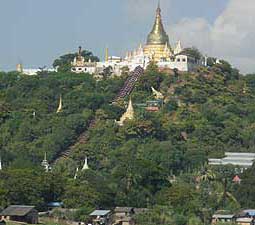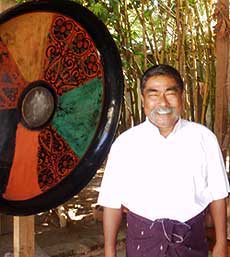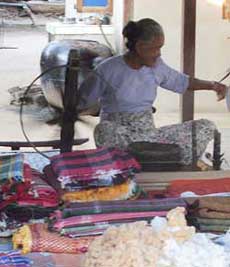|
THE TRULY GOLDEN LAND - BURMA

The Spanish went in search of a fabled city of gold in South America in the 17th century. They should have gone East, East to the Golden Land of Burma. Flying into Yangon, the land positively glitters with the precious metal, as countless peaks of pagodas covered in gold stretch across the horizon, testament to the Buddist faith that informs this nation.
Burma is the great new travel destination, a land at last opening up after years of isolation.
Eager to see it before the onset of Western influence and inspired by Kipling's evocative verse, we were provided with a gliding platform along the Irrawaddy River by the 'Road to Mandalay' ship of the Orient Express.
The opulence on board was certainly at odds with the lifestyle of the Burmese villages we visited along the way but some measure of mitigation could be derived from the contribution the ship makes to this country. While moored at Mandalay for three days, the ship's doctor saw some 500 people a day in the hospital that the Orient Express has helped establish. Patients travelled many miles and queued all day and night to see him, and though his capacity for treatment was obviously limited, he and his assistants were able to give some advice, some medicine, and referrals to hospitals. Two British doctors travelling on the ship came away from seeing him at work and were in awe of his ability.
At top, pagodas at sunset on the plain of Pagan. Above, part of the mighty Shwedagon temple, its huge golden stupa rising in the background. Below, villagers making bead bangles.
 Arriving in Yangon in winter temperatures in the mid-20s C, 80s fahrenhiet, it lived up to imagined expectations of a teeming Asian city, street markets everywhere, frantic traffic, a backdrop of grand old colonial buildings gone to seed, and the colourful, exuberant, cheerful citizens offering all manner of goods for sale from tiny stalls everywhere. And looming above it all, the amazing Shwedagon pagoda, a monumental and truly stunning site, at the heart of the city and the country's Buddhist faith. Arriving in Yangon in winter temperatures in the mid-20s C, 80s fahrenhiet, it lived up to imagined expectations of a teeming Asian city, street markets everywhere, frantic traffic, a backdrop of grand old colonial buildings gone to seed, and the colourful, exuberant, cheerful citizens offering all manner of goods for sale from tiny stalls everywhere. And looming above it all, the amazing Shwedagon pagoda, a monumental and truly stunning site, at the heart of the city and the country's Buddhist faith.
The Burmans come to this and all the others pagodas throughout the country, venerating the immense Buddha statues that are present in many.
It is hard for secular visitors to appreciate, but the gold leaf that covers these statues and the pagodas comes mainly from locals.At one village we visited, a pagoda had recently been renovated with gold and the £40,000-plus expense was largely covered by nearby residents who might well be thought to be rather more in need themselves.
But if the people are poor, the country  itself is abundantly rich. A recent British television series highlighted the richness of the Burmese jungle and its wildlife. In addition, all manner of flowers, fruit, vegetables grow in profusion, and there are many other natural resources - oil, minerals, rice. All the jade in China comes from Burma, all the teak wood. We saw the last shipments of teak on their way to China, as a ban is just coming in that will mean, or should mean, that the Burmese keep and use the wood themselves for export. itself is abundantly rich. A recent British television series highlighted the richness of the Burmese jungle and its wildlife. In addition, all manner of flowers, fruit, vegetables grow in profusion, and there are many other natural resources - oil, minerals, rice. All the jade in China comes from Burma, all the teak wood. We saw the last shipments of teak on their way to China, as a ban is just coming in that will mean, or should mean, that the Burmese keep and use the wood themselves for export.
Carts are still the main form of tranport, though cars and motorbikes are rapidly increasing. The taxi above provided a bumpy ride over village tracks, a jolly contrast to the smooth comfort of the 'Road to Mandalay', below.
In all this abundance, the poverty is all the more stark. Yet the Burmese are the most delightful, elegant and charming of people, men and women alike dressed in the traditional longhi 'skirts', the women often with faces painted with the taneka cream powder, some young men sporting the tufted hairdo's of popular Asian football figures.
Football is a national obsession, the poorest villages sporting satellite dishes to ensure TV reception of international games. It was introduced into the country by a buccaneering British adventurer-turned-colonial-official, one George Scott, in the 1870s. He was responsible for opening up and mapping much of the country, a fearless fellow out of a Boys Own adventure story, who used football to engage with some of the country's most savage natives,  including head hunters. (It's claimed that this practice only finally died out in the 1970s.) including head hunters. (It's claimed that this practice only finally died out in the 1970s.)
Cruising along the Irrawaddy provides a much more comfortable means of exploring this fascinating country than Scott endured, all other transport somewhat rudimentary, and up in the hills little changed from his time. From a vantage point on deck, the passing panorama of scattered dwellings at the waters edge, villagers washing and playing in the water, an occasional giant buddha, and the ever present pagodas was made all the more delightful with a glass in hand.
It is a luxury vessel, as to be expected from the Orient Express. Considerable efforts are made to provide passengers with information on the country, with lectures and cultural presentations, and as a small ship, it has a friendly, intimate  atmosphere. We enjoyed excellent food and an exotic selection of cocktails, the deck bar the perfect spot to appreciate the countryside. atmosphere. We enjoyed excellent food and an exotic selection of cocktails, the deck bar the perfect spot to appreciate the countryside.
Moored at Mandalay, we watched the sun set across the water, bringing alight the glistening pagodas on Mandalay Hill. Though Kipling never actually visited Mandalay, his poem about it would certainly have stirred fond memories in many old soldiers of the Raj who had been there, and reflected his own delight in Burma and, in particular, the beauty of Burmese ladies.
One of the major pagodas that top hills,above, and below, one of the few burly Burmans that we came across, a master of the lacquerware craft, his longhi tied deftly at the waist.
The town itself is pretty dusty and busy, the Burma Road, made infamous during World War ll, the main artery for goods to and from China. From here, we journeyed up to visit a small town in the Shan region that had been a British outpost in colonial times, Maymyo. Named after a Colonel May, who founded it as a retreat from the heat of Mandalay, it was very much modelled upon the style of a British country town. Now, the neat bungalows and  suburban villas are mainly occupied by rich Indians or Chinese, while the town centre still has the clock tower from British clockmaker Purcell, still working. suburban villas are mainly occupied by rich Indians or Chinese, while the town centre still has the clock tower from British clockmaker Purcell, still working.
The trip up was spectacular, a winding road through the Highlands. And all along the way, tips of pagodas could be seen on the horizon. Nearby, in the Sericulture Research Centre, millions of silkworms are reared, a forest of mulberry trees providing leaves for them, and their cocoons then reeled of their silk on site. Though this may end up in luxury shops around the world, little reward has so far been enjoyed by the locals - but hopefully this will be changing.
Pagan is the fabled pagoda centre along the Irrawaddy, with over 2,000 of them scattered across a wide plain. We scrambled up the largest, a pyramid-type giant that became a teaming mass of tourists over its many ledges, there to witness and,  more specifically, to photograph the sunset that would illuminate so many pagodas. more specifically, to photograph the sunset that would illuminate so many pagodas.
Tourism is certainly helping to open up the country and many more visitors will be arriving in the coming seasons. There are wonderful sights to be seen, quite apart from the golden pagodas, and Burmese craftsmanship to be appreciated. In Yangon, there is a wealth of quality jewellery shops and some fine art galleries - but caveat emptor must be the tourists' maxim, according to our guide.
An ancient spinning wheel seen above, very much in use. Below, a huge golden Buddha beside the Irrawaddy, surrounded by monks.
Visiting the war graves cemetary was a very moving experience, some 27,000 British and allied servicemen buried at just one of the three sites in Yangon. Beautifully mantained, the row upon row of marble head stones testified to the youth of so many buried here, and the inscribed messages from loved ones conveyed the anguish they felt.
And moving from one sad experience to another, we were taken to view three 'ceremonial' elephants, three great beasts chained and shackled on a small raised platform, one shuffling three steps forwards and three back. A pitiable sight and one uncharacteristic in a country that generally has an humane and kindly attitude. Perhaps they too may soon enjoy greater freedom.
Marie Scott travelled with Audley Travel, the cost of the trip, including international flights and three nights in Yangon, plus the Orient Express inclusive seven day Irrawaddy cruise, around £6,500. www.audleytravel.com
|